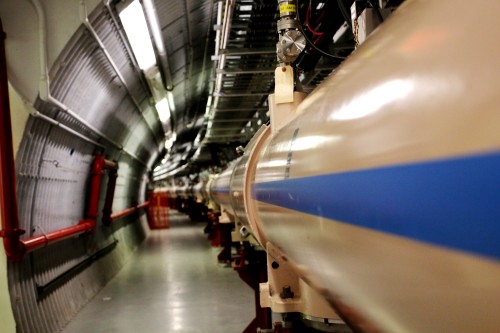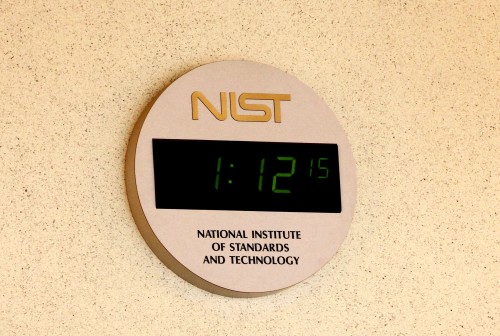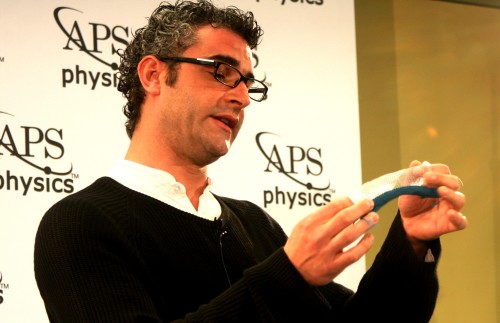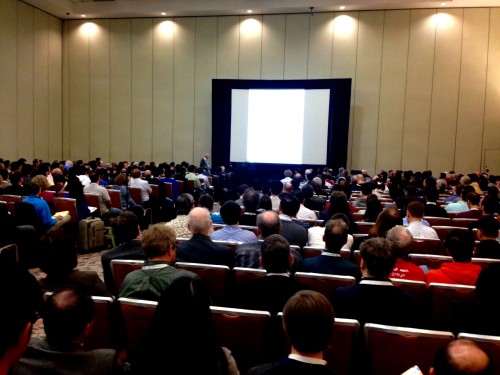Posts by: Tushna Commissariat
The unexpected benefit of a malfunctioning magnet at RHIC

Beam me down: in the RHIC tunnel. (Courtesy: Tushna Commissariat)
By Tushna Commissariat in New York City, US
I’m not one to rejoice in someone else’s misfortune, but I must admit that I couldn’t help but be a bit pleased when I heard that the Relativistic Heavy Ion Collider (RHIC) at the Brookhaven National Laboratory (BNL) had a malfunction last Friday. You see, I happened to be visiting the collider and its detectors yesterday, and if a malfunctioning superconducting magnet had not shorted a diode last Friday, I would not have had the chance to go down into the collider tunnel, which was a great experience.
RHIC – which, along with the Large Hadron Collider at CERN, is the only other detector capable of colliding heavy ions and is, in fact, the only spin-polarized collider in the world – has been running since the year 2000, and accelerator director Wolfram Fischer tells me that I am rather “lucky” as “failed magnets are very rare”. Indeed, he said that after initial teething problems when RHIC was switched on, this was the first such magnet failure that has occurred in the past 15 years. But fear not, the RHIC maintenance crew is already hard at work – the diode will soon be replaced and the collider should be up and running again in the next few days.
Setting the standards for physics

Keepers of time: at the NIST campus in Gaithersburg. (Courtesy: Tushna Commissariat)
By Tushna Commissariat in New York City, US
As most of our regular blog readers will know, last week Physics World‘s Matin Durrani and I were in Baltimore attending the APS March meeting. While we spent most of the week at the conference centre, last Friday we visited the National Institute of Standards and Technology’s (NIST) Gaithersburg campus, as well as the Joint Quantum Institute (JQI), which is based at the University of Maryland. It was a jam-packed, exciting day that we spent zipping around to and from more than 10 different labs and departments, meeting people who use physics to do everything from improve the safety of body armour to redefining the kilogram.
As we saw so many interesting projects, covering them all would make for a rather long read. Instead, join me for a quick visual tour of NIST below (I will cover our JQI visit in a separate blog) to get a small taste of the physics and people involved.
Getting a fix on quantum computations

Bit of choice: A photograph of the nine superconducting qubit device developed by the Martinis group at the University of California, Santa Barbara, where, for the first time, the qubits are able to detect and effectively protect each other from bit errors. (Courtesy: Julian Kelly/Martinis group)
By Tushna Commissariat in New York City, US
Although the APS March meeting finished last Friday and I am now in New York visiting a few more labs and physicists in the city (more on that later), I am still playing catch-up, thanks to the vast number of interesting talks at the conference. One of the most interesting sessions of last week, and a pretty popular one at that, was based on “20 years of quantum error correction” and I went along to the opening talk by physicist John Preskill of the California Institute of Technology. I had the chance to catch up with Preskill after his talk and we discussed just why he thinks that we are not too far away from a true quantum revolution.
Just in case you haven’t come across the subject already, quantum error correction is the science of protecting quantum information (or qubits) from errors that would occur as the information is influenced by the environment and other sorts of quantum noise, causing it to “decohere” and lose its quantum state. Although it may seem premature that scientists have been working on this problem for nearly two decades when an actual quantum computer has yet to be built, we know that we must account for such errors if our quantum computers are ever to succeed. It will be essential if we want to achieve fault-tolerant quantum computation that can deal with all sorts of noise within the system, as well as faults in the hardware (such as a faulty gate) or even a measurement.
Over the past 20 years, theoretical work in the field has made scientists confident that quantum computing of the future will be scalable. Preskill says that “it’s exciting because the experimentalists are taking it quite seriously now”, while initially the interest was mainly theoretical. Previously, scientists would artificially create the noise in the quantum systems that they would correct but now actual quantum computations can be fixed. Indeed, Preskill says that one of the key things that has really moved quantum error correction along in the past few years is the concentrated improvement of the hardware used, i.e. better gates with multiple qubits being processed simultaneously.
The everyday physics of knitting, ribbon-curling and more

Knit stitch: Frédéric Lechenault talks about the physics of knitted materials. (Courtesy: James Riordon/APS)
By Tushna Commissariat in Baltimore, Maryland, US
You may think that a simple occurrence such as a tree shedding its leaves or an everyday activity such as knitting or ribbon-curling does not involve a great deal of physics, but you would be wrong. In a press session here at the APS March meeting entitled “The physics of everyday life”, three different groups of researches talked about the unexpectedly complex physical principles that govern all of the above mentioned instances.
Sunny Jung of the Bio-Inspired Fluid Lab at Virginia Tech in the US studies the shapes of different leaves and the thickness of their “petioles” or stalks – both of which determine the stresses a leaf can withstand on a windy day and what happens when it ultimately falls. Jung’s team studies this because leaves are actually very good at withstanding all kinds of stress and strain without buckling – something that could be applied to large man-made industrial objects such as suspended road-signs.
The researchers found that slender leaves are more likely to bend under high winds, whereas a flat leaf is more likely to twist at the stem before falling. They also discovered that the length of the stalk is determined by the size of the leaf, with larger leaves needing longer stems so that sunlight can cover more of their surface area.
Would you encourage your grandchildren into condensed-matter physics?

Packed in: a full room for Anthony Leggett’s talk. (Courtesy: Tushna Commissariat)
By Tushna Commissariat in Baltimore, Maryland, US
One of the most popular talks this morning at the APS March meeting was almost certainly given by Nobel-prize-winning physicist Anthony Leggett of the University of Illinois at Urbana-Champaign in the US. Leggett, who shared the 2003 Nobel Prize for Physics for his work on superconductors and superfluids, talked about his “Reflections on the past present and future of of condensed-matter physics”.
As the abstract of his talk suggests, Leggett looked at the ways, means and even the very definition of “condensed-matter physics” has changed and “evolved since its inception in the early 20th century, with particular reference to its relationship to neighbouring and even distant disciplines”. He went on to “speculate on some possible directions in which the discipline may develop over the next few decades, emphasizing that there are still some very basic questions to which we currently have no satisfactory answers”.
I missed the beginning of his talk as I was attending the morning’s first set of press briefings (more on those later) but when I did walk into the packed hall for his talk, his slide had the rather interesting title: “Would I encourage my grandchildren to go into condensed-matter physics?” Happlily enough, his answer at the end of his talk was a resounding “yes”.
Baltimore braces itself for physics

March madness: the APS March meeting at the Baltimore Convention Center (top) and the IOP Publishing stand at the exhibition. (Courtesy: Tushna Commissariat)
By Matin Durrani and Tushna Commissariat in Baltimore, Maryland, US
So here we are in Baltimore to attend the 2016 March meeting of the American Physical Society (APS). We’re writing this at the window seats in a burrito bar on Pratt Street while staring at the hulk that is the Baltimore Convention Center, where nigh-on 10,000 physicists will be congregating all week.
We’ve been playing a game of “spot the APS attendee” while tucking into our burritos. Without wishing to stereotype physicists (okay, go on then, we will) they’re the ones with the backpacks stuffed with poster tubes, pulling little trolley suitcases, looking lost before veering towards the convention centre.
There are also some physicists inside Chipotle Mexican Grill – you can tell because they’re huddled around laptops looking at PowerPoint presentations showing graphs of Fermi surfaces and topological insultators. Probably not the usual subject of discussion in here.
Lilting to the LIGO tune, Fukushima five years on and more
By Tushna Commissariat
Looks as if LIGO’s gravitational-wave discovery is still rocking all over the world, as you can now groove to the dulcet tones of singer and physicist Tim Blais, who runs the acapellascience channel on YouTube. With some help from the Perimeter Institute in Canada, the singer has created his latest “nerd-pop” parody, titled “LIGO Feel That Space” (sung to the tune of The Weeknd’s “Can’t Feel My Face”). After you listen to the catchy tune above, take a look at this interview with Blais on the Perimeter website to find out just how he creates his songs and how he went from physicist to a viral YouTuber.
Primates and paradoxical twins in the ISS, cosmic musicals, alien advertising and more
By Tushna Commissariat
The International Space Station (ISS) usually has only the human variety of primate on board, but earlier this week a gorilla seemed to have joined the crew. If you thought that this was part of one of the hundreds of planned experiments on the ISS you would be wrong. Instead, it was crew member Scott Kelly’s birthday hijinks after his twin brother sent him the suit for his birthday as the astronaut celebrated a year in space. Kelly will return to Earth in six days’ time.
Interestingly, this is the first time NASA has sent up one half of a pair of twins into space and is studying just how life on the ISS will change Scott’s physiology from that of his twin Mark. Apart from looking at how life in space will alter everything from Scott’s DNA to his gut microbes, this is also a real-life variation of the “twin paradox” experiment where Scott will return to the planet a bit “younger” than his twin in that Scott’s clock runs a bit slower than Mark’s, thanks to the ISS’s orbital speed of 17,000 mph. After reading this, if you feel like you would like a go on the ISS, NASA is currently hiring.
View all posts by this author | View this author's profile
Surfing the LIGO wave, sounding out black holes and more
By Matin Durrani and Tushna Commissariat
Unless you are completely disconnected from all electronic media, the Internet and don’t read a newspaper, by now you must have heard that the LIGO Virgo collaboration has made the first ever detection of gravitational waves, spewed out by two black holes merging into one. The story made waves across the world, if you will excuse the pun, and seemed to capture the interest of scientists and the public alike. Above you can listen to the chirp of the merger event, dubbed GW150914, that occurred 1.3 billion years ago, when multicellular life was just emerging on Earth. Indeed, these sounds are so intriguing that they are being turned into musical compositions.
